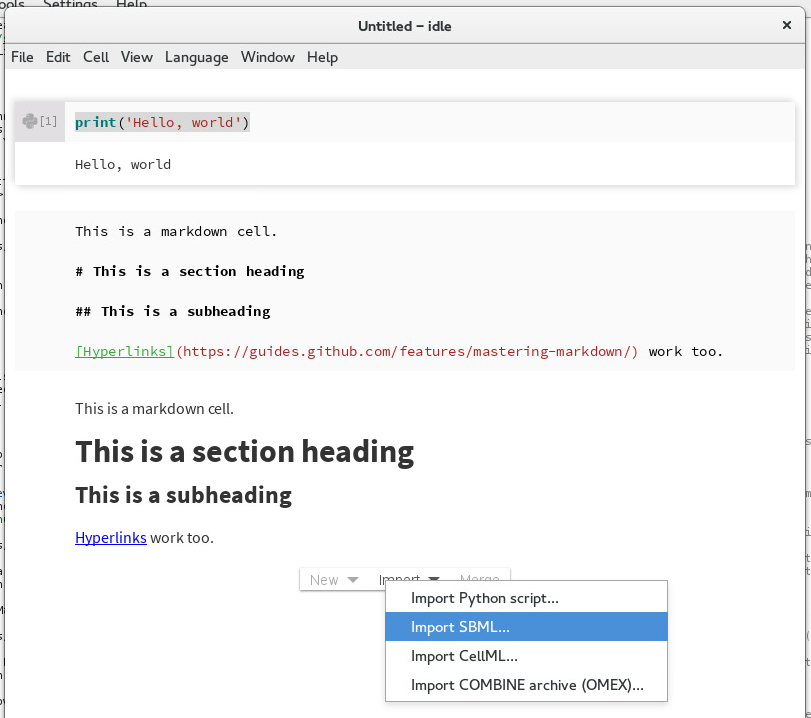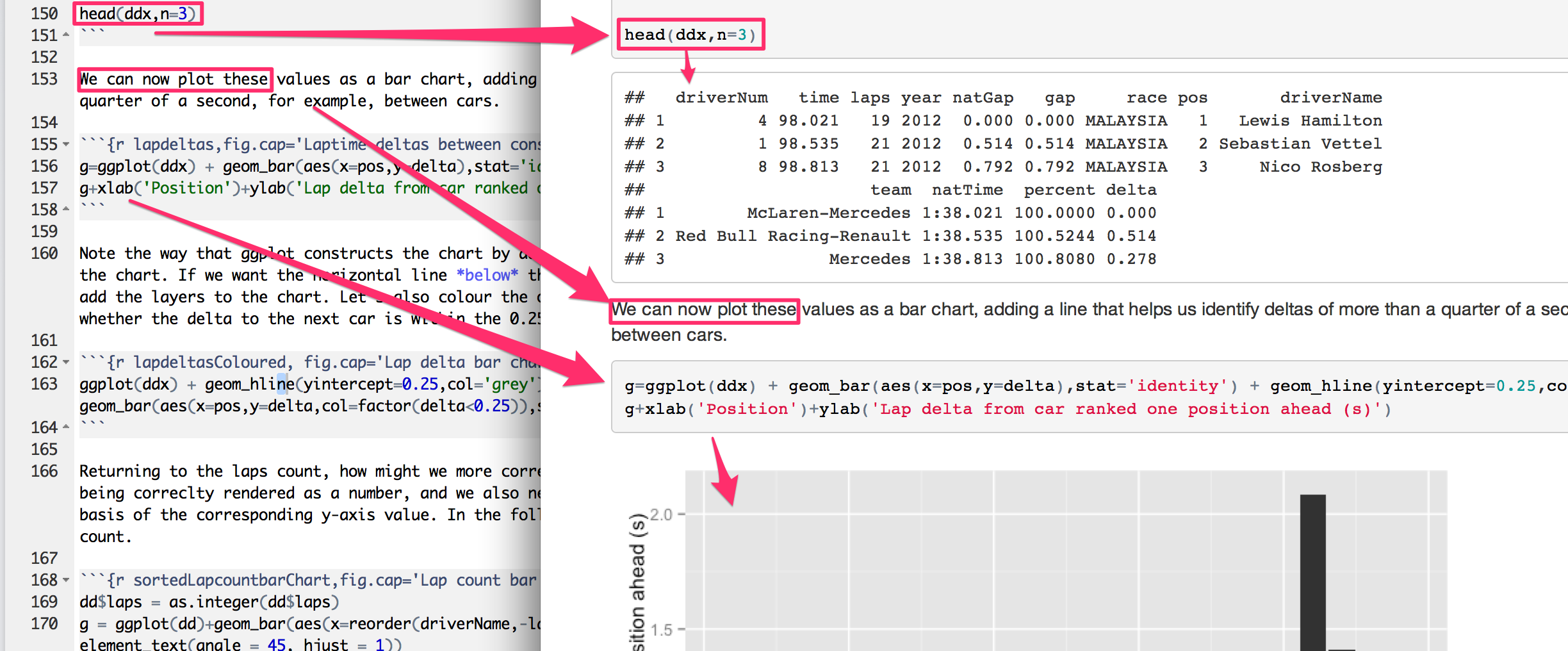Markdown is a lightweight Markup language with a plain text syntax. John Gruber developed the Markdown language in 2004 in a collaborative effort with Aaron Swartz, intending to enable people to.
- Markdown In Python Jupyter Notebook
- Markdown In Python Notebook
- Using Markdown In Python
- Markdown In Python Function
Here are some of the keyboard shortcuts and text snippets I’ve shared with others during Pair Programming sessions that have been well received. They’ve saved me countless hours programming and my hope is you’ll be able to start using some of these techniques to become a more efficient Python programmer.
- Python IPython.display.Markdown Examples The following are 26 code examples for showing how to use IPython.display.Markdown. These examples are extracted from open source projects. You can vote up the ones you like or vote down the ones you don't like, and go to the original project or source file by following the links above each example.
- You can attach image files directly to a notebook in Markdown cells by dragging and dropping it into the cell. To add images to other cell types, use graphics that are hosted on the web with this code, substituting url/name with the full URL and name of the image.
Keyboard shortcuts

Taking a few minutes to learn certain Jupyter Notebook keyboard shortcuts has helped me be a more efficient Python developer. Below are the keyboard shortcuts I’ve found most useful.
NOTE these keyboard shortcuts are for Jupyter version 4.1.0 and Mac OSX. For most shortcuts below, you can replace cmd for ctrl for Windows or Linux. Or, you can use the H keyboard shortcut in Windows or Linux to confirm the appropriate keyboard shortcuts for those operating systems.
Practice Jupyter Notebook
I created this Jupyter Notebook on my Github repo that you can download and use to practice these keyboard shortcuts.
Command mode vs. Edit mode
But first…something key to be aware of: Jupyter Notebooks have two different keyboard input modes:
- Command mode - binds the keyboard to notebook level actions. Indicated by a grey cell border with a blue left margin.
- Edit mode - when you’re typing in a cell. Indicated by a green cell border
Command Mode
shift+enterrun cell, select belowctrl+enterrun celloption+enterrun cell, insert belowAinsert cell aboveBinsert cell belowCcopy cellVpaste cellD,Ddelete selected cellshift+Mmerge selected cells, or current cell with cell below if only one cell selectedI,Iinterrupt kernel0,0restart kernel (with dialog)Ychange cell tocodemodeMchange cell tomarkdownmode (good for documentation)
Edit Mode
cmd+clickfor multi-cursor editingoption+scrolling clickfor column editingcmd+/toggle comment linestabcode completion or indentshift+tabtooltipctrl+shift+-split cell
Command Palette

cmd + shift + p
Want quick access to all the commands in Jupyter Notebooks? Open the command palette with cmd + shift + p and you’ll quickly be able to search all the commands!
View all keyboard shortcuts
H (in Command mode)
Forget what that keyboard shortcut is? Type H in Command mode for a list of all available keyboard shortcuts.
Text snippets
Text snippets allow me to save time typing and keep things consistent.
For my text snippets, I use Textexpander which is Mac OSX only. However, for Windows I’ve used PhraseExpress in the past which works well too.
Quick imports for all your favorite packages
Constantly importing the same packages and/or forget what that package you always use is named? I like to store my default imports in a snippet such as the following. I’d recommend you create a similar snippet and tune it to your preferences.
;imp becomes:
Making writing functions and documentation less painful
I like to remind myself to write a function DocString every time I write a function by using the following snippet.
;def becomes:
This is a Python implementation of John Gruber’s Markdown. It is almost completelycompliant with the reference implementation, though there are a few very minordifferences. See John’s Syntax Documentation for the syntax rules.
First and foremost, Python-Markdown is intended to be a python library moduleused by various projects to convert Markdown syntax into HTML.
The Basics¶

To use markdown as a module:
The Details¶
Python-Markdown provides two public functions (markdown() and markdownFromFile()) both of which wrap thepublic class Markdown. If you’re processing onedocument at a time, the functions will serve your needs. However, if you needto process multiple documents, it may be advantageous to create a singleinstance of the class:`Markdown class and pass multiple documents throughit.
markdown.markdown(text[, **kwargs])¶Markdown In Python Jupyter Notebook
The following options are available on the markdown.markdown function:
text (required): The source text string.
Note that Python-Markdown expects Unicode as input (althougha simple ASCII string may work) and returns output as Unicode.Do not pass encoded strings to it! If your input is encoded, (e.g. asUTF-8), it is your responsibility to decode it. For example:
If you want to write the output to disk, you must encode it yourself:
extensions: A list of extensions.
Python-Markdown provides an API for third parties to write extensions tothe parser adding their own additions or changes to the syntax. A fewcommonly used extensions are shipped with the markdown library. Seethe [extension documentation](extensions/index.html) for a list ofavailable extensions.
The list of extensions may contain instances of extensions or strings ofextension names. If an extension name is provided as a string, theextension must be importable as a python module either within themarkdown.extensions package or on your PYTHONPATH with a name startingwith mdx_, followed by the name of the extension. Thus,extensions=[‘extra’] will first look for the modulemarkdown.extensions.extra, then a module named mdx_extra.
extension_configs: A dictionary of configuration settings for extensions.
The dictionary must be of the following format:
See the documentation specific to the extension you are using for help inspecifying configuration settings for that extension.
output_format: Format of output.
Supported formats are:* “xhtml1”: Outputs XHTML 1.x. Default.* “xhtml5”: Outputs XHTML style tags of HTML 5* “xhtml”: Outputs latest supported version of XHTML (currently XHTML 1.1).* “html4”: Outputs HTML 4* “html5”: Outputs HTML style tags of HTML 5* “html”: Outputs latest supported version of HTML (currently HTML 4).
Note that it is suggested that the more specific formats (“xhtml1”,“html5”, & “html4”) be used as “xhtml” or “html” may change in the futureif it makes sense at that time. The values can either be lowercase oruppercase.
safe_mode: Disallow raw html.
If you are using Markdown on a web system which will transform textprovided by untrusted users, you may want to use the “safe_mode”option which ensures that the user’s HTML tags are either replaced,removed or escaped. (They can still create links using Markdown syntax.)
The following values are accepted:
- False (Default): Raw HTML is passed through unaltered.
- replace: Replace all HTML blocks with the text assigned to
- html_replacement_text To maintain backward compatibility, settingsafe_mode=True will have the same effect as safe_mode=’replace’.
To replace raw HTML with something other than the default, do:
- remove: All raw HTML will be completely stripped from the text with
no warning to the author.
escape: All raw HTML will be escaped and included in the document.
For example, the following source:
Will result in the following HTML:
Note that “safe_mode” also alters the default value for theenable_attributes option.
html_replacement_text: Text used when safe_mode is set to replace. Defaults to [HTML_REMOVED].
tab_length: Length of tabs in the source. Default: 4
enable_attributes: Enable the conversion of attributes. Defaults to True, unless safe_mode is enabled, in which case the default is False.
Note that safe_mode only overrides the default. If enable_attributesis explicitly set, the explicit value is used regardless of safe_mode.However, this could potentially allow an untrusted user to injectJavaScript into your documents.
smart_emphasis: Treat _connected_words_ intelligently Default: True
lazy_ol: Ignore number of first item of ordered lists. Default: True
Given the following list:
By default markdown will ignore the fact the the first line startedwith item number “4” and the HTML list will start with a number “1”.If lazy_ol is set to True, then markdown will output the followingHTML:
Markdown In Python Notebook
markdown.markdownFromFile(**kwargs)¶With a few exceptions, markdownFromFile() accepts the same options asmarkdown(). It does not accept a text (or Unicode) string.Instead, it accepts the following required options:
Using Markdown In Python
input (required): The source text file.
input may be set to one of three options:
- a string which contains a path to a readable file on the file system,
- a readable file-like object,
- or None (default) which will read from stdin.
output: The target which output is written to.
output may be set to one of three options:
- a string which contains a path to a writable file on the file system,
- a writable file-like object,
- or None (default) which will write to stdout.
- encoding: The encoding of the source text file. Defaults
to “utf-8”. The same encoding will always be used for input and output.The ‘xmlcharrefreplace’ error handler is used when encoding the output.
Note: This is the only place that decoding and encoding of unicodetakes place in Python-Markdown. If this rather naive solution does notmeet your specific needs, it is suggested that you write your own codeto handle your encoding/decoding needs.
markdown.Markdown([**kwargs])¶Markdown In Python Function
The same options are available when initializing the Markdown classas on the markdown() function, except that the class doesnot accept a source text string on initialization. Rather, the source textstring must be passed to one of two instance methods:
Markdown.convert(source)¶The source text must meet the same requirements as the textargument of the markdown() function.
You should also use this method if you want to process multiple stringswithout creating a new instance of the class for each string.:
Note that depending on which options and/or extensions are being used,the parser may need its state reset between each call to convert.:
You can also change calls to reset together:
Markdown.convertFile(**kwargs)¶The arguments of this method are identical to the arguments of the samename on the markdownFromFile() function (input, output, and encoding).As with the convert() method, this method should be used toprocess multiple files without creating a new instance of the class foreach document. State may need to be reset between each call toconvertFile() as is the case with convert().
